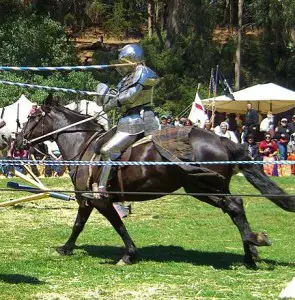
It is easy to forget when looking at later portraits of Henry VIII and hearing about him being so overweight and ill that he had to be carried around on a special chair, that Henry VIII was once a keen sportsman. He was not just an enthusiastic sportsman, he was actually good as well.
One sport which Henry excelled at was jousting. There were originally two types of jousting:
- Jousts of War: Here knights used sharp, solid lances and aimed to unhorse their opponent.
- Jousts of Peace: Here knights used rebated, hollow lances and aimed was to strike their opponent and shatter their lance.1
Jousts of war became less popular after 1480, so Henry VIII and his fellow knights would have been taking part in jousts of peace. Royal armouries explain what these jousts were like:
“From the 13th century these started to be fought between two combatants on horseback using blunted lances. The new lance-heads had several prongs to spread the force of a blow. Each competitor tried to break his own lance against his opponent’s armour. Plate armour was developed so that the left side of the body was reinforced to withstand the shock of impact. The ‘frogmouthed’ helm was also developed, with its projecting lip to protect the face from flying wooden splinters. In time a barrier was introduced, separating the two contestants to prevent collisions. This barrier was called a ‘tilt’, which is why a Joust of Peace using a barrier was also called a ‘tilt’ or ‘tilting’.”2
Henry VIII had taken part in his first joust as king on 12 January 1510 at Richmond Park at a private joust – click here to read more about that.
The King’s skill at jousting was mentioned by Luis Caroz de Villaragut, writing to Ferdinand of Aragon in May 1510, who also recorded that the King ran at the ring and practised jousting and combat “almost every day of the week”:
“There are many young men who excel in this kind of warfare, but the most conspicuous amongst them all, the most assiduous, and the most interested in the combats is the King himself, who never omits being present at them.”3
In April 1515, Sebastian Giustinian, the Venetian ambassador at Henry VIII’s court, wrote:
“After dinner, a stately joust took place, at which His Majesty jousted with many others, strenuously and valorously; and assuredly […] this most serene King is not only very expert in arms, and of great valour, and most excellent in his personal endowments […]”4
But jousting was a very dangerous sport. Courtier William Compton was injured jousting in January 1510 and was described as “likely to dye”. He made a full recovery, going on to serve the King as groom of the stool until 1526, when he was removed in Cardinal Wolsey’s purge of the privy chamber. There is no mention of him suffering any permanent injury and he died of sweating sickness in 1528.
Others weren’t so lucky. At the Field of Cloth of Gold in 1520 a Frenchman was killed in a joust against his brother. Sir Francis Bryan lost an eye at the Shrovetide joust of 1526, and Henry II of France died in 1559 a few days after his opponent’s lance struck his helmet and a long splinter pierced his eye and penetrated his brain. People have also been killed re-enacting jousting – in 2007 a professional jousting re-enactor was killed after a splinter sheared off a 7ft wooden lance and went through his eye and brain while filming an episode of Time Team.
Henry VIII was injured at least twice while jousting. On this day in history, 10th March 1524, he was injured after he forgot to lower his visor in a joust against Charles Brandon, Duke of Suffolk. According to the records, “the duke struck the king on the brow right under the guard of the headpiece on the very skull cap or basinet piece”, splintering and sending splinters into the King’s helmet.5
Fortunately the King survived the blow but a mortified Suffolk vowed that he would never joust against the King again. The King laughed it off, saying that it was no-one’s fault and that he and his sight were saved. He went on to run six courses to show that he had not been seriously hurt. The joust had been organised to test out the King’s new armour, which was made to “his own design and fashion”. You can read Edward Hall’s full account of the accident in my article from 2014 – click here.
Of course, Henry VIII was to suffer a more serious jousting accident in January 1536 – click here to read about that.
Notes and Sources
Image: Jousting at the Golden Gate Renaissance fair, San Francisco, California, Wikipedia.
Henry VIII the Jouster, talk by Claire Ridgway, March 2015, Tudor Society.
- Tournament Events, Royal Armour, https://www.royalarmouries.org/leeds/leeds-galleries/tournament-gallery/tournament-events
- Ibid.
- Calendar of State Papers, Spain, Volume 2, 1509-1525, 45.
- Giustiniani, Sebastiano, 1460-1543, Four years at the court of Henry VIII : selection of despatches, p. 75-76.
- Hall’s Chronicle, Edward Hall, p674